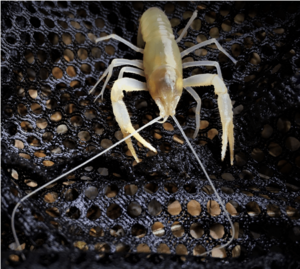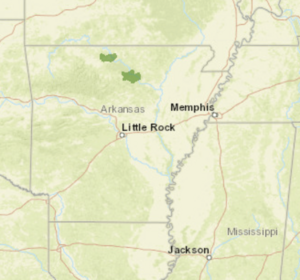Hell Creek Cave crayfish facts for kids
Quick facts for kids Hell Creek Cave crayfish |
|
|---|---|
 |
|
| Conservation status | |
| Scientific classification | |
| Genus: |
Cambarus
|
| Species: |
zophonastes
|
The Cambarus zophonastes, also known as the Hell Creek Cave crayfish, is a special type of crayfish. It gets its name from Hell Creek Cave, where it was first found. You can also find it in other caves and springs in Stone County and Marion County, Arkansas. One of these places is Nesbitt Spring Cave.
This crayfish is in big trouble. It is listed as critically endangered by the IUCN. This means it's very close to disappearing forever. It's also protected by the ESA in the United States. People are working hard to save it. They watch its numbers, try to keep its home safe, and check the water quality. More research is needed to help this unique creature survive.
What it Looks Like
The Hell Creek Cave crayfish is quite unusual. It has no color, so it looks pale or white. It also does not have eyes, which is common for animals living in dark caves. This crayfish grows to be about 2.5 to 3.0 inches long.
It has a pointed part on its head called a rostrum. This is like a beak-shaped shell between where its eyes would be. A small, narrow area on its back is called the areola. You can tell it apart from its close relatives, C. setosus and C. tartarus, because they have wider areolas.
Life Cycle
We don't know much about the life of the Hell Creek Cave crayfish. This is because it's very hard to find and observe. In 1975, scientists found one female carrying eggs. This gave them some clues about how it reproduces.
Its breeding habits are probably similar to other troglobites. Troglobites are animals that live only in caves. These cave animals often reproduce in late winter and spring. This is when water levels are higher in the caves. More water means more food and nutrients for reproduction. Cave animals usually have few babies and take a long time to grow up. But their babies have a better chance of surviving. Scientists think this crayfish might live for about 40 years. This idea comes from studies of similar crayfish in Florida.
How it Lives
What it Eats
The food in these cave habitats comes from outside. When it rains, floods bring organic matter (like dead leaves or tiny bits of plants) into the caves. Scientists haven't studied exactly what the Hell Creek Cave crayfish eats. But they can guess by looking at what similar crayfish eat.
For example, C. robustus filters tiny algae from the water. C. tenebrosus eats plants and sometimes small animals like frogs or salamanders. So, the Hell Creek Cave crayfish likely eats organic matter filtered from the water. It might also sometimes eat other small cave animals.
How it Behaves
Since the Hell Creek Cave crayfish has no eyes, it doesn't react to light. But it can tell when someone tries to catch it. The caves where it lives don't have much food. This means the crayfish needs to save energy. It probably moves very slowly or stays still most of the time.
Because food is scarce, these crayfish likely eat whatever they can find. They are "opportunistic foragers." We need more research to understand how they find mates or defend their space.
Where it Lives
The Hell Creek Cave crayfish lives in streams inside caves in Arkansas. It likes muddy stream bottoms or cave walls. These places are completely dark and have a steady, cool temperature. The water in these caves is usually stable. But it can flood when it rains a lot. The crayfish prefers these same conditions in all the places it's found.
Where it is Found
For many years, people thought the Hell Creek Cave crayfish only lived in Hell Creek Cave. But in 2005, another group of these crayfish was found in Nesbitt Spring cave. This cave is in the same county. Then, in 2010, a third group was found near the Town Branch River in Yellville, Arkansas.
These new discoveries don't mean the crayfish is spreading to new places. It's more likely that scientists are now exploring more areas. They are finding populations that have always been there. So far, no known groups of C. zophonastes have disappeared. This means their living areas are probably staying the same.
Range Map
You can see an interactive map of where this crayfish lives at ECOS. The dark green parts show where the Hell Creek Cave Crayfish is found in Arkansas, U.S.A.
How Many There Are
In 2018, surveys showed a small drop in the number of crayfish seen in Hell Creek Cave. But this might not mean fewer crayfish overall. In the past, scientists checked all parts of the caves, even the parts they had to dive into. Now, they only check the parts they can walk through. This makes it harder to know the exact number of crayfish.
Looking at older, full surveys: Hell Creek Cave had 15 crayfish in 1983, 13 in 1990, and 12 in 2007. Nesbitt Spring cave had "dozens" in 1992 and 9 in 2004. These numbers are helpful, but they don't give a full picture of the total population.
As of 2018, there are three confirmed groups of this crayfish. They are in Hell Creek Cave, Nesbitt Spring, and the Yellville Town Branch Creek System. There might be a fourth group, but it hasn't been fully confirmed yet.
Saving the Crayfish
Main Dangers
The biggest dangers to the Hell Creek Cave crayfish are changes and damage to its home. Its habitat can be broken up by things like erosion and sedimentation from human activities. Habitat damage often comes from pollution. This includes things like dirty water from cities (urban runoff) and improper waste disposal.
Other dangers include people collecting the crayfish. Also, human presence can disturb them. These crayfish have very few numbers. They also have a low birth rate and take a long time to grow up. Because they are troglobites, they are very sensitive to human disturbance. Even just people being in their cave can stress them. Caves have very little energy because there are no primary producers (like plants) making food. Any energy the crayfish wastes reacting to humans can hurt their chances of survival and reproduction. Losing even a few eggs from a female could greatly harm the whole population.
How it Became Protected
The Hell Creek Cave crayfish was asked to be protected under the Endangered Species Act on May 5, 1986. It officially became an endangered species on April 7, 1987. A plan to help it recover was made in 1988.
Reviews have been done over the years to check on its status. The most recent review in 2019 kept it listed as endangered. It suggested ways to improve its status to "threatened." These ideas included better rules for land use, stopping recreational cavers from entering, and finding and protecting more groups of crayfish. Conservationists can do this by protecting caves, teaching locals about the cave ecosystem, checking water quality, and watching the crayfish's health.
Current Efforts to Save It
The plan to save the Hell Creek Cave crayfish was made in 1988 and hasn't been updated. It's now in its final stage, so efforts need to continue. To change its status from endangered to threatened, three healthy groups of crayfish need to be found and protected. To remove it from the endangered list completely, ten groups must be found, and five healthy groups must be fully protected.
Because these crayfish live only in caves, it's hard to find so many new groups. Also, since there are so few of them, moving them or breeding them in captivity could harm the existing population. So, it's unlikely they will be taken off the endangered list soon. There isn't a special "critical habitat" area set aside for this species yet.
What Has Been Done
To protect the Hell Creek Cave crayfish, Hell Creek Cave and the area that supplies its water must be safe. An agreement was made with the Arkansas Natural Heritage Commission (NHC) and the Arkansas Game and Fish Commission. Signs were put up, and a barrier was built to stop people from entering without permission. Also, the Ozark Underground Laboratory helped identify all the land that feeds water into the cave.
What is Being Done Now
Many things are being done to protect the crayfish. One important part is protecting the land that recharges Hell Creek Cave's water. Any new projects that need state or federal approval are checked to make sure they won't harm the crayfish.
Getting local people involved is also helpful. This means teaching them how fragile the cave and its animals are. Locals can also help by reporting things that might hurt the cave, like chemical spills on nearby highways.
Collecting Information
Looking for New Groups
Scientists are still looking for new groups of crayfish, and they've had some success. The species has been found in two more caves and a spring in Stone County. It's also in a spring in Marion County, Arkansas. Researchers keep exploring caves and water habitats where the crayfish might live. It's harder to do research in places humans can't easily reach, like the Yellville site.
Studying Populations
Scientists collect information about the crayfish numbers. They compare new data to old data. This helps them see if protection efforts are working. It also helps them plan how to manage and save the species.
Checking Water Quality
Water quality is regularly checked. This helps scientists find out about pollution levels and how healthy the water habitat is for the crayfish.




